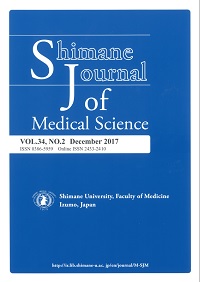Shimane University Faculty of Medicine
ISSN :0386-5959(in print)
ISSN :2433-2410(online)


These article are licensed under a Creative Commons Attribution-NonCommercial-NoDerivatives 4.0 International License.
number of downloads : ?
Use this link to cite this item : https://ir.lib.shimane-u.ac.jp/40553
Shimane Journal of Medical Science 34 1
2017-07-31 発行
Diseases With Extremely Elevated Erythrocyte Sedimentation Rates in a Secondary Healthcare Facility: Retrospective Cohort Study
Ohta, Ryuichi
Unnan City Hospital
Kaneko, Makoto
Musashikoganei Clinic, Japanese Health and Welfare Co-operative Federation
Hattori, Shuzo
Unnan City Hospital
File
Description
Background: There is no data about the frequency of diseases with extremely elevated erythrocyte sedimentation rate (ESR) in secondary healthcare facilities in Japan.
Methods: We conducted a retrospective cohort study in Unnan City hospital in Shimane Prefecture to find out the frequency of diseases with ESR of more than 100 mm at one hour in a secondary healthcare facility in Japan. We gathered information on patients at the outpatient and emergency outpatient departments at the time of arrival and their final diagnosis.
Results: The total number of participants was 56, consisting of 19 men and 37 women. The average age recorded was 77.8 years. There were 30 cases (53.6%) of NIID(Non-infectious inflammatory disease), 10 cases (17.9%) of infectious diseases, 10 cases (17.9%) of malignancy, 2 cases (3.6%) of other diagnoses, and 4 cases (7.1%) of unknown diagnoses. The most prevalent disease among patients with ESR of more than 100 mm at one hour was pseudogout.
Conclusion: There may be specific prevalence of the diseases with ESR of over 100 mm at one hour in rural hospitals. In diagnosing the patients showing extremely high ESR, It may be important to consider the possibility of the specific diseases in rural hospitals in Japan.
Methods: We conducted a retrospective cohort study in Unnan City hospital in Shimane Prefecture to find out the frequency of diseases with ESR of more than 100 mm at one hour in a secondary healthcare facility in Japan. We gathered information on patients at the outpatient and emergency outpatient departments at the time of arrival and their final diagnosis.
Results: The total number of participants was 56, consisting of 19 men and 37 women. The average age recorded was 77.8 years. There were 30 cases (53.6%) of NIID(Non-infectious inflammatory disease), 10 cases (17.9%) of infectious diseases, 10 cases (17.9%) of malignancy, 2 cases (3.6%) of other diagnoses, and 4 cases (7.1%) of unknown diagnoses. The most prevalent disease among patients with ESR of more than 100 mm at one hour was pseudogout.
Conclusion: There may be specific prevalence of the diseases with ESR of over 100 mm at one hour in rural hospitals. In diagnosing the patients showing extremely high ESR, It may be important to consider the possibility of the specific diseases in rural hospitals in Japan.
About This Article
Rights
Faculty of Medicine, Shimane University
Other Article
PP. 7 - 11
PP. 13 - 19
